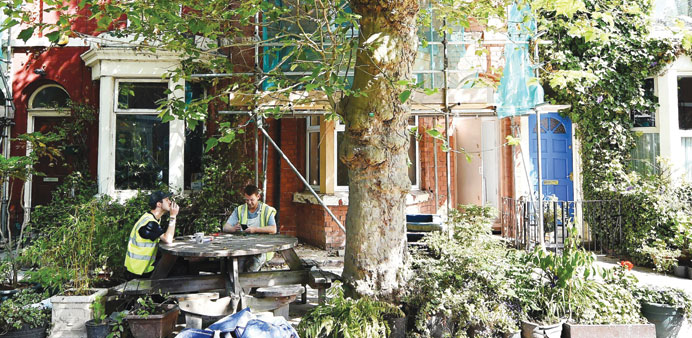DPA/London
When a group of young architects decided to transform a disused London petrol station into a glittering, pop-up cinema in 2010, most of them saw it as a one-off project.
But the now 18-strong collective, united by a lack of faith in the principles of many projects and in Britain’s system of qualification for architects, has quietly built its profile through small projects aimed at reviving abandoned spaces and dilapidated structures.
Interest in the collective, known as Assemble, grew after it was shortlisted for the Turner Prize, Britain’s biggest art award, and looks set to mushroom again after judges declared it the winner late Monday.
Assemble was nominated for, among other projects, its collaboration with local residents in the Granby Four Streets project in the run-down, multi-racial Toxteth area of the north-western city of Liverpool.
The collective, which includes some artists and other non-architects, has catalysed a long-term project by the Granby Four Streets Community Land Trust (CLT) to revive neglected 100-year-old terraced houses.
Anthony Engi Meacock, one of Assemble’s founders, told DPA before Monday’s award that he and other members, who are mostly in their mid-20s, had mixed feelings about the “completely surprising and unexpected” Turner shortlisting.
“I was more uncertain than some people,” Engi Meacock said at Assemble’s Sugarhouse Studios, a renovation project that includes workshops and the collective’s office in East London. But Engi Meacock took to the stage in Glasgow on Monday to accept the prize with other Assemble members who said they were “completely humbled” by the award.
“I think what swayed it for us is, the people in the CLT were really happy for us and really thought it was great,” he said. “If they’d been negative we’d have turned it down.”
“It felt uncomfortable that we were being made out to be these kind of saviours and that most of the work’s been done by them [local residents],” Engi Meacock says.
Erika Rushton, the CLT’s chair, said Assemble had joined “a creative process in Granby that began when residents stopped just going to endless meetings and started taking back their own streets”.
Initially helping to refurbish 10 houses, a workshop and a winter garden, Assemble aims to “celebrate the value of the area’s architectural and cultural heritage”, support public involvement, offer training and employment opportunities, and “nurture the resourcefulness and DIY [do-it-yourself] spirit that defines the four streets”.
It has participated in nearly 30, mostly small projects, but that had already changed after it won a competition to create a community-focused art gallery for Goldsmiths College at the University of London in an old bathhouse.
Group members Paloma Strelitz and Adam Willis told the university they “envisage the gallery becoming a new centre for the arts in South London”.
“It’s a lot bigger, in terms of scale,” Engi Meacock said of the gallery, which is designed to bring Goldsmiths College closer to local people in an area where it “feels very separate”.
The Turner judges praised Assemble for their work “in tandem with communities to realise a ground up approach to regeneration, city planning and development in opposition to corporate gentrification”.
“They draw on long traditions of artistic and collective initiatives that experiment in art, design and architecture,” the judges said, and show the importance of “artistic practice being able to drive and shape urgent issues in the post-industrial era.”
There is a strong moral commitment behind the collective’s work, Engi Meacock said.
“I have very limited time for architects who claim they don’t have a moral responsibility.”
The collective still operates with just one full-time administrator, and the architects cover most of the financial and organisational work.
“Our way of working gets negotiated very slowly, but it’s a completely flat hierarchy,” Engi Meacock said.
“No one’s in charge of any project but, administratively, each project has generally two ‘buddies’ and they’re responsible for the day-to-day running of the project, and I guess report back to the rest of the group.”
When Assembly started there was no aspiration for it to be a company, he said.
“The first project did well, and we were asked to do more, and it was sort of rewarding, and I think that’s the only reason why it worked.”
The negotiation of their cooperation was “very personal” and they do not promote any “model that’s worthy of copying,” he said.
“If other people think it’s useful for them to learn from it, that’s great, but I wouldn’t think of ourselves as having a manifesto or dogma.”

Builders take a break outside one of the houses designed by Assemble.


